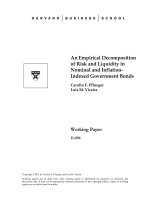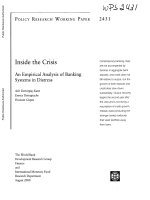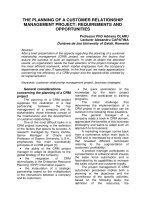An empirical exploration of customer relationship management practices in banking industry: A study of Indian private sector banks
Bạn đang xem bản rút gọn của tài liệu. Xem và tải ngay bản đầy đủ của tài liệu tại đây (613.29 KB, 12 trang )
Journal of Applied Finance & Banking, vol. 6, no. 5, 2016, 161-172
ISSN: 1792-6580 (print version), 1792-6599 (online)
Scienpress Ltd, 2016
An Empirical Exploration of Customer Relationship
Management Practices in Banking Industry: A Study of
Indian Private Sector Banks
Basman al Dalaeen1 and Anas Khan2
Abstract
Customer relationship management CRM is a managerial philosophy that seeks to build
long term relationships with customers, assisting in customer retention, and driving sales
growth. The paper is review of customer relationship management practices prevalent in
Indian banking industry. In this research, an attempt has been undertaken to measure the
differences in the perception of customer’s of selected banks on CRM practices namely
empathy, responsiveness, reliability, and customer relations. The researchers employed
275 respondents of four private sector banks as the sample and collected data through
questionnaires designed on a five point Likert scale. This paper used one way ANOVA as
the statistical tool to measure the variation in the perception of bank customer towards
CRM dimensions. The analysis of the data revealed that no significant variation exists in
the perception of customers on CRM dimensions like empathy, responsiveness,
reliability, and customer relations.
JEL classification numbers:
Keywords: ANOVA, CRM, bank and customers.
Note: The present study has been divided into five sections. Section A presents the
introductory background and literature review while objectives, hypotheses, and research
design have been elucidated in section B. Besides, section C discusses the demographic
profile of the respondents and section D explains data analysis and hypothesis testing.
Conclusion, limitations of the study, and directions for further research are the subject
matter of section E.
1
2
Faculty of business administration and economics, al- Hussein bin talal university.
Research Scholar, Department of Commerce, Aligarh Muslim University, Aligarh-202002.
Article Info: Received : June 22, 2016. Revised : July 17, 2016.
Published online : September 1, 2016
162
Basman al Dalaeen and Anas Khan
1 Introduction
The profitability of the banking sector is mainly depending on the services offered by the
banks and on meeting the customer demands on a regular basis and therefore all banks
especially private sector banks emphasized more on adopting CRM. Customer
relationship management (CRM) is a term that refers to practices, strategies and
technologies that companies use to manage and analyze customer interactions and data
throughout the customer lifecycle. The goal of CRM is improving business relationship
with customers, assisting in customer retention, and driving sales growth (Kimar &
Reinartz, 2012). It is a managerial philosophy that seeks to build long term relationships
with customers. It can be defined as the development and maintenance of mutually
beneficial long-term relationships with strategically significant customers (Buttle, 2002).
Customers Relationship Management (CRM) is a broad term that covers concepts used by
companies to manage their relationship with customers, including the capture, storage and
analysis of customer information (Parvatiyar & Sheth, 2002). The objectives of customer
relationship management are as follows: to create customer loyalty; to maintain profitable
relationships with customers; to increase the productivity of the firm; to meet the
customer needs and demands; to enable cost minimization and harmonious activities
(Yim, Anderson, & Swaminathan, 2005). Therefore, an attempt has been made by the
authors to empirically examine the differences in the perception of customers of selected
banks on CRM practices namely empathy, responsiveness, reliability, and customer
relations. Four private sector banks as shown in the table below have been finally selected
for making analysis and interpretation.
Table 1: An overview of selected private sector banks
Source: www.mapsofindia.com
Name of the
Established
As on 31st July 2015
Bank
Year
No
Branches
Market Capitalization
(in Crores)
HDFC
1994
3659
261,226.94
1
ICICI
1994
4050
184,547.26
2
AXIS
1994
2402
134,685.68
3
Yes Bank
2004
1214
35,169.20
4
2 Review of Related Literature
Varghese & Ganesh (2004) in their research article titled “Customer Service in Banks:
An Empirical Study” highlighted three mantras for the success of any organization like
bank. These are courtesy, accuracy and speed. The study is based on primary data
collected through questionnaires. A sample of 456 customers has been selected from ten
public sector and thirteen private sector bank branches operating in Kerala. The study
revealed that there is no difference between the public and private sector banks with
regard to speed but significant difference exist between the public and private sector
banks with regard to accuracy and responsiveness. The authors have emphasized on the
speed of rendering service that sets apart one bank from another. Kumar, Anjana &
An Empirical Exploration of Customer Relationship Management Practices
163
Kavita (2006) in their research article titled “e- CRM in Banks” highlighted the
importance of e-CRM in banking industry. Their study revealed that increased sales,
increased revenues, increased convenience, improved customer service rating, decreased
administrative costs, ability to introduce new schemes at a faster rate, improved speed of
dissemination of information etc are the offshoots of e-CRM. Rao (2006) in his article
titled “Customer Service in Banks” suggested that any bank wants to grow in size must
apply the five steps. These are: acquiring new customers, retaining the existing customers,
increasing revenues, reducing the cost and focusing on diversifying and profitable
business preposition. Mittal (2008) in his research article entitled, “Empirical Study of
Relationship Marketing in Indian Banks (Customers' Perspective)” analyzed the
customer's opinion about their bank and compared the relationship marketing in public
and private sector banks. The survey revealed that significant difference exists with
respect to the application of relationship marketing in public sector & private sector
banks. The author has suggested that the attitude of bank employees especially managers
in public sector banks should be changed completely so that customers can be properly
served. Madan, Agrawal, & Matta (2015) in their article titled “Relationship Marketing
Strategies in Banking Sector: A Review” have observed that relationship marketing means
attracting, maintaining and enhancing customer relationships. The authors revealed that
trust, commitment and bonds hold important roles in order to maintain, enhance, and
develop long-term relationships between businesses and customers.
3 Objectives of the Study
1) To investigate the variation in the perception of customers on empathy (one of the
CRM dimension) across selected banks.
2) To analyze the variation in the perception of customers on reliability (one of the CRM
dimension) across selected banks.
3) To find out the variation in the perception of customers on responsiveness (one of the
CRM dimension) across selected banks.
4) To investigate variation in the perception of customers on customer relations (one of
the CRM dimension) across selected banks.
3.1 Hypotheses of the Study
Following null and alternative hypotheses have been developed for the study.
Ho1: There is no significant variation in the perception of customers on empathy (one of
the CRM dimension) across selected banks.
Ha1: There is a significant variation in the perception of customers on empathy (one of the
CRM dimension) across selected banks.
Ho2: There is no significant variation in the perception of customers on reliability (one of
the CRM dimension) across selected banks.
Ha2: There is a significant variation in the perception of customers on reliability (one of
the CRM dimension) across selected banks.
Ho3: There is no significant variation in the perception of customers on responsiveness
(one of the CRM dimension) across selected banks.
164
Basman al Dalaeen and Anas Khan
Ha3: There is a significant variation in the perception of customers on responsiveness (one
of the CRM dimension) across selected banks.
Ho4: There is no significant variation in the perception of customers on customer relations
(one of the CRM dimension) across selected banks.
Ha4: There is a significant variation in the perception of customers on customer relations
(one of the CRM dimension) across selected banks.
3.2 Research Design
Population: The population of this study consists of all customers of private sector
banks in India.
Size of the Sample: The size of the sample is 275 customers of four private sector
banks selected from different cities by way of questionnaire. Table 2.1 shows the
sample size for the study. A total of 275 respondents have been selected from four
banks in which 90 from HDFC bank, 84 from ICICI bank, 59 from Axis bank, and 42
from Yes bank.
Table 2.1: Sample Size
Name of Selected Banks
Number of Customers
90
84
59
42
275
HDFC Bank
ICICI Bank
AXIS Bank
YES Bank
Total
Source: Primary Data
Data collection: A well designed questionnaire set on a five point Likert-scale (5highly satisfied to 1-highly dissatisfied) has been used for collecting data from
Aligarh, Agra, Delhi, Ghaziabad, Gurugram, Noida and Chandigarh. Table 2.2 shows
questionnaires distributed, rejected, accepted and response rate. A total of 400
questionnaires have been distributed in which 125 have been rejected due to error.
Hence, 275 questionnaires have been finally selected and considered as the sample
size for the study.
Table 2.2: Shows the Questionnaires Distributed, Rejected and Accepted
Questionnaires
Distributed
Questionnaires
Rejected
Questionnaires
Accepted
Response
Rate
120
120
90
70
400
30
36
31
28
125
90
84
59
42
275
75%
70%
65%
60%
69%
Name of Private
Sector Banks
HDFC Bank
ICICI Bank
AXIS Bank
YES Bank
Total
Source: Primary Data
An Empirical Exploration of Customer Relationship Management Practices
165
Tools: Since there are four banks, one way Analysis of Variance (ANOVA) has been
used as the statistical tool to test the hypotheses through Statistical Package for Social
Science (SPSS_19).
4 Demographic Profile of Respondents
4.1 Age of the Respondents
Table 3 and figure 1 highlight the age of the respondents of selected banks. 66
respondents were fall in the age limit of 20-35 years. Besides, 139 respondents belong to
the age of 35-50 years whilst 70 were of the age of more than 50 years. In HDFC Bank,
42 respondents were belong to the age limit of 35-50 years where as 31 respondents in
AXIS Bank were of the age limit of 35-50 years.
Age of Customers
Table 3: Shows the Age of the respondents
Banks
YES
HDFC
ICICI
AXIS
25
20-35 Years
42
35-50 Years
23
Above 50 Years
Total
90
Source: Primary Data
17
44
23
84
13
31
15
59
Total
11
22
9
42
66
139
70
275
Fig.1: Age of the respondents
20-35 Years
35-50 Years
Above 50 Years
44
42
31
25
23
23
17
HDFC
22
15
13
ICICI
AXIS
11
9
YES Bank
Figure 1: Age of the respondents
Table 4: Gender of the Respondents
Gender
HDFC
ICICI
AXIS
50
48
32
Male
40
36
27
Female
Total
90
84
59
Source: Primary Data
YES
25
17
42
Total
155
120
275
166
Basman al Dalaeen and Anas Khan
Fig.2: Gender of the respondents
No. of respondents
60
50
40
30
20
10
0
HDFC
ICICI
AXIS
YES
Figure 2: Gender of the respondents
Table 4 and figure 2 highlight the gender of the respondents of the selected banks. Out of
275 respondents, 155 were males and 120 were females. In HDFC bank, 50 and 40 were
males and females. Besides, 48 and 32 males were found in ICICI and Axis Bank
respectively.
Education
Upto XII
Graduation
Post Graduation
Others
Total
Source: Primary Data
Table 5: Education of the Respondents
HDFC
ICICI
AXIS
YES
7
6
5
5
41
38
24
15
31
33
17
13
11
7
13
9
90
84
59
42
Total
23
118
94
40
275
Table 5 and figure 3 exhibit the education of the selected respondents. It has been found
that maximum respondents (118) were graduates followed by 94 post graduates.
Minimum respondents (23) have education till class XII. Besides, 40 respondents were
doctors, Chartered Accountants (CA), engineers, etc.
An Empirical Exploration of Customer Relationship Management Practices
167
Fig.3 Education of the respondents
45
40
35
30
25
20
15
10
5
0
HDFC
ICICI
Upto XII
Graduation
AXIS
Post Graduation
YES Bank
Others
Figure 3: Education of the respondents
5 Data Analysis and Hypothesis Testing
5.1 Reliability Testing
Cronbach alpha is considered as the most accepted statistical tool to check reliability of
the data. The value of α between 0.7 - 0.9 is considered good and the value of α greater
than 0.9 is considered excellent. Table 5 highlights the reliability of all four dimensions
of the study. The value of Cronbach alpha of all CRM dimensions is ranging from 0.7 to
0.9 and the overall reliability is 0.872. Therefore, it can be said that the data is reliable for
further analysis.
Table 6: Reliability of all Dimensions
No.
Dimensions
No. of Items
Cronbach’s Alpha
Empathy
4
0.894
1
Reliability
5
0.746
2
Responsiveness
5
0.914
3
Customer Relations
7
0.834
4
Overall Reliability
21
0.872
Source: Output of SPSS_19
Hypothesis Testing
Hypothesis 1
Ho1: There is no significant variation in the perception of customers on empathy (one
of the CRM dimension) across selected banks.
Ha1: There is a significant variation in the perception of customers on empathy (one of
the CRM dimension) across selected banks.
One way ANOVA has been used as a statistical tool to examine the variation in the
perception of customers on empathy across selected banks. The null hypothesis is that
168
Basman al Dalaeen and Anas Khan
there is no significant variation in the perception of customers on the CRM dimension on
empathy (one of the CRM dimension) across selected banks and the alternate hypothesis
is that there is a significant variation in the perception of customers on the CRM
dimension on empathy across selected banks.
Table 7: ANOVA of Empathy
Sum of Squares
df
Mean Square
817.876
3
272.666
Between Banks
1274.192
271
4.701
Within Banks
2092.068
274
Total
Source: Output of SPSS_19
F
68.25
Sig.
0.834
Table 7 shows the results of one way ANOVA used to find out the variations in the
perception of customers on empathy (CRM dimension) across selected banks. The pvalue is 0.834 which is more than 0.05 at 95 percent confidence interval. Therefore, null
hypothesis is accepted and hence it can be said that there is no significant variation in the
perception of customers on empathy (one the CRM dimension) across selected banks.
Hypothesis 2
Ho2: There is no significant variation in the perception of customers on reliability (one
of the CRM dimension) across selected banks.
Ha2: There is a significant variation in the perception of customers on reliability (one
of the CRM dimension) across selected banks.
One way ANOVA has been used as a statistical tool to examine the variation in the
perception of customers on reliability across selected banks. The null hypothesis is that
there is no significant variation in the perception of customers on the CRM dimension on
reliability (one of the CRM dimension) across selected banks and the alternate hypothesis
is that there is a significant variation in the perception of customers on the CRM
dimension of reliability across selected banks.
Table 8: ANOVA of Reliability
Sum of Squares
323.949
Between Banks
1196.573
Within Banks
1520.522
Total
Source: Output of SPSS_19
df
3
271
274
Mean Square
107.983
4.416
F
24.456
P Value
0.766
Table 8 shows the results of one way ANOVA used to find out the variations in the
perception of customers on reliability across selected banks. The p-value is 0.766 which is
more than 0.05 at 95 percent confidence interval. Therefore, null hypothesis stands
accepted and hence it can be said that there is no significant variation in the perception of
customers on reliability (one the CRM dimension) across selected banks.
An Empirical Exploration of Customer Relationship Management Practices
169
Hypothesis 3
Ho3: There is no significant variation in the perception of customers on responsiveness
(one of the CRM dimension) across selected banks.
Ha3: There is a significant variation in the perception of customers on responsiveness
(one of the CRM dimension) across selected banks.
One way ANOVA has been used as a statistical tool to examine the variation in the
perception of customers on responsiveness across selected banks. The null hypothesis is
that there is no significant variation in the perception of customers on the CRM dimension
on responsiveness (one of the CRM dimension) across selected banks and the alternate
hypothesis is that there is a significant variation in the perception of customers on the
CRM dimension on responsiveness across selected banks.
Table 9: ANOVA of Responsiveness
Sum of Squares
477.160
Between Banks
1135.088
Within Banks
1612.248
Total
Source: Output of SPSS_19
df
3
271
274
Mean Square
159.053
4.188
F
37.965
P Value
0.654
Table 9 shows the results of one way ANOVA used to find out the variations in the
perception of customers on responsiveness across selected banks. The p-value is 0. 654
which is more than 0.05 at 95 percent confidence interval. Therefore, null hypothesis
stands accepted and hence it can be said that there is no significant variation in the
perception of customers on responsiveness (one the CRM dimension) across selected
banks.
Hypothesis 4
Ho4: There is no significant variation in the perception of customers on customer
relations (one of the CRM dimension) across selected banks.
Ha4: There is a significant variation in the perception of customers on customer
relations (one of the CRM dimension) across selected banks.
One way ANOVA has been used as a statistical tool to examine the variation in the
perception of customers on customer relations across selected banks. The null hypothesis
is that there is no significant variation in the perception of customers on the CRM
dimension on customer relations (one of the CRM dimension) across selected banks and
the alternate hypothesis is that there is a significant variation in the perception of
customers on the CRM dimension on customer relations (one of the CRM dimension)
across selected banks.
170
Basman al Dalaeen and Anas Khan
Table 10: ANOVA of Customer relations
Sum of Squares
597.430
Between Banks
3123.637
Within Banks
3721.067
Total
Source: Output of SPSS_19
df
3
271
274
Mean Square
199.333
11.52
F
17.302
Sig.
0.223
Table 10 shows the results of one way ANOVA used to find out the variations in the
perception of customers on customer relations across selected banks. The p-value is 0.223
which is more than 0.05 at 95 percent confidence interval. Therefore, null hypothesis is
accepted and hence it can be said that there is a significant variation in the perception of
customers on customer relations (one the CRM dimension) across selected banks.
No
1
2
3
4
Table 11: Shows the P Value and Results of Hypothesis Tested
HYPOTHESES
P Value
There is no significant variation in the perception of 0.834
customers on empathy (one of the CRM dimension) across
selected banks.
There is no significant variation in the perception of 0.766
customers on reliability (one of the CRM dimension) across
selected banks.
There is no significant variation in the perception of 0.654
customers on responsiveness (one of the CRM dimension)
across selected banks.
There is no significant variation in the perception of 0.223
customers on customer relations (one of the CRM
dimension) across selected banks.
Results
Accepted
Accepted
Accepted
Accepted
6 Conclusion
Customer relationship management (CRM) is a term that refers to practices, strategies and
technologies that companies use to manage and analyze customer interactions, and data
throughout the customer lifecycle. The goal of CRM is improving business relationships
with customers, assisting in customer retention, and driving sales growth. In the present
study, an attempt has been made by the authors to empirically examine the differences in
the perception of customers of four private sector banks selected from different cities of
North India like Aligarh, Agra, Delhi, Ghaziabad, Gurugram, Noida and Chandigarh. A
total of 400 questionnaires (set on a five point likert scale) have been distributed in which
125 have been rejected because of several mistakes. Hence, 275 questionnaires have been
finally selected and considered as the sample size for the study. Before hypotheses testing,
cronbach alpha has been applied as the statistical tool to check reliability of the data. It
has been found that the overall reliability of all variables is 0.872 which shows that the
data is reliable for further analysis. Nevertheless, one way Analysis of Variance
(ANOVA) has been used as the statistical tool to test the hypotheses through Statistical
An Empirical Exploration of Customer Relationship Management Practices
171
Package for Social Science (SPSS_19). The first hypothesis has been rejected which
shows that there is no significant variation in the perception of customers on empathy
(one of the CRM dimension) across selected banks. Similarly, the second hypothesis has
been rejected meaning thereby no significant variation in the perception of customers on
reliability (one of the CRM dimension) across selected banks. Further, the third
hypothesis has also been rejected which shows that there is no significant variation in the
perception of customers on responsiveness (one of the CRM dimension) across selected
banks. Finally, the fourth hypothesis has been rejected meaning thereby no significant
variation in the perception of customers on customer relations (one of the CRM
dimension) across selected banks.
6.1 Limitations of the Study
The data has been collected from few districts due to time and cost constraints. Besides,
the data collection period is only six months since August, 2015 to January, 2016.
Further, the sample size is small with respect to total population.
6.2 Directions for Further Research
The current study is based on small sample size taken from seven cities of North India
and therefore, the results cannot be generalized to other cities of India especially in the
analytical terms. Further research can be conducted by taking more private sector banks
and more number of respondents. Moreover, the present study examine the differences in
the perception of customers on CRM variables of private sector banks only and hence
similar study may be conducted by taking a sample of public sector banks.
References
[1]
[2]
[3]
[4]
[5]
[6]
[7]
[8]
[9]
Buttle, F. (2002). The SCOPE of Customer Relationship Management. Available: at
llibrary.
Kumar,N; Anjana, K; & Kavita, G. (2006). e- CRM in Banks. Abhinav-International
Monthly Refereed Journal of Research in Commerce & Management, Vol.8, pp.4548.
Kimar, V., & Reinartz, W. (2012). Customer Relationship Management. Concept,
Strategy and Tools. Springer Berlin Heidelberg, pp. 55-85.
Mittal, G. (2008). Empirical Study of Relationship Marketing in Indian Banks
(Customers' Perspective). Amity Business Review, Vol.11, pp.22-25.
Madan, R; Agrawal,R; & Matta, M.G. (2015). Relationship Marketing Strategies in
Banking Sector: A Review. International Journal of BRIC Business Research
(IJBBR) Vol.4, Number 4, pp.1-10.
Parvatiyar, A; & Sheth J.N. (2002). Customer Relationship Management: Emerging
Practice, Process, and Discipline, J. Econ. Soc. Res., 3(2):1-34.
Peppers, D. & Rogers, M. (2004). Managing Customer Relationships: A Strategic
Framework. Canada: John Wiley & Sons.
Rao, S. (2006). Customer Service in Banks. International Research Journal of Social
Sciences, Vol.13, pp.36-39.
172
Basman al Dalaeen and Anas Khan
[10] Varghese, M.E. & Ganesh, C. (2004). Customer Service in Banks: An Empirical
Study. Vinimaya, Vol. 24, No. 2, 24-30.
[11] Verma , S., Chaundhuri, R. (2009), Effect of CRM on Customer Satisfaction in
Service Sector in India. Journal of Marketing and Communication, 5(2), 55-69.
[12] Yim, F.H., Anderson, R.E., Swaminathan, S. (2005), Customer Relationship
Management: Its Dimensions and Effect on Customer Outcomes. Journal of
Personal Selling and Sales Management, 24(4), pp.265–280.









